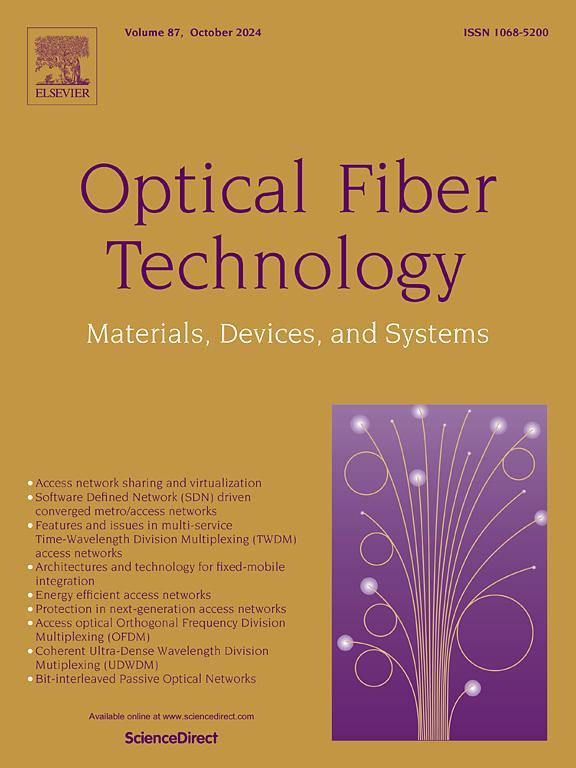ACOP-MB:放大器工作点优化,以提高多频段场景下的QoT
IF 2.7
3区 计算机科学
Q2 ENGINEERING, ELECTRICAL & ELECTRONIC
引用次数: 0
摘要
由于互联网用户的增加和对更高带宽服务的需求,对数据的需求不断增长,给网络基础设施带来了巨大的压力。在这种情况下,最大限度地提高光网络的效率一直是公司和学术团体的共同努力。解决这一挑战的一个有希望的方法是使用多波段光传输,这使得增加光链路的数据传输容量成为可能。该解决方案不是简单地扩展物理基础设施,而是寻求最大限度地利用现有资源。由于SRS(受激拉曼散射)效应在多波段场景中显著存在,以及衰减和有效面积等波长相关参数增加了这些场景的复杂性,因此需要对链路上每个波段的发射功率和放大器进行组合和同时优化过程。因此,在这项工作中,我们提出了一种新的方法来优化多频段场景下的QoT(传输质量),称为ACOP-MB(工作点多频段自适应控制),它使用遗传算法进行优化。我们考虑了360和440公里的光链路,同时在S、C和L波段的386个传输通道,以及EDFAs(掺铒光纤放大器)和TDFA(掺铥光纤放大器)。该方法在360公里距离内实现了14.34 dB的广义信噪比(GSNR),比传统的损失补偿方法增益约7 dB。此外,在研究的场景中,ACOP-MB的传输速率比损耗补偿方法高32 Tb/s左右,表明其在优化先进光网络中多频段系统性能方面的潜力。本文章由计算机程序翻译,如有差异,请以英文原文为准。
ACOP-MB: Amplifiers operating point optimization to increase QoT in multiband scenarios
The growing demand for data, driven by the increase in internet users and the need for higher bandwidth services, puts significant pressure on network infrastructures. In this context, maximizing the efficiency of optical networks has been a common effort among companies and academic groups. One promising approach to tackling this challenge is the use of multi-band optical transmissions, which make it possible to increase the data transmission capacity of an optical link. Rather than simply expanding the physical infrastructure, this solution seeks to maximize the use of existing resources. Due to the SRS (Stimulated Raman Scattering) effect, which is significantly present in multiband scenarios, as well as the wavelength-dependent parameters such as attenuation and effective area that increase complexity in these scenarios, a combined and simultaneous optimization process is required for the launch power and amplifiers for each band present on the link. Therefore, in this work, we present a new approach to optimizing QoT (Quality of Transmission) in a multiband scenario, called ACOP-MB (Adaptive Control of Operating Point - Multiband), which uses a genetic algorithm for optimization. We considered optical links with 360 and 440 km, 386 transmission channels in the S, C and L bands simultaneously, and EDFAs (Erbium Doped Fiber Amplifiers) and TDFA (Thulium Doped Fiber Amplifier). The proposed approach achieved a GSNR (Generalized Signal-to-Noise Ratio) of 14.34 dB over a distance of 360 km, representing a gain of approximately 7 dB over traditional loss compensation approach. In addition, ACOP-MB presented a transmission rate around 32 Tb/s higher when compared to the loss compensation approach, in the studied scenario, demonstrating its potential for optimizing the performance of multiband systems in advanced optical networks.
求助全文
通过发布文献求助,成功后即可免费获取论文全文。
去求助
来源期刊

Optical Fiber Technology
工程技术-电信学
CiteScore
4.80
自引率
11.10%
发文量
327
审稿时长
63 days
期刊介绍:
Innovations in optical fiber technology are revolutionizing world communications. Newly developed fiber amplifiers allow for direct transmission of high-speed signals over transcontinental distances without the need for electronic regeneration. Optical fibers find new applications in data processing. The impact of fiber materials, devices, and systems on communications in the coming decades will create an abundance of primary literature and the need for up-to-date reviews.
Optical Fiber Technology: Materials, Devices, and Systems is a new cutting-edge journal designed to fill a need in this rapidly evolving field for speedy publication of regular length papers. Both theoretical and experimental papers on fiber materials, devices, and system performance evaluation and measurements are eligible, with emphasis on practical applications.
 求助内容:
求助内容: 应助结果提醒方式:
应助结果提醒方式:


